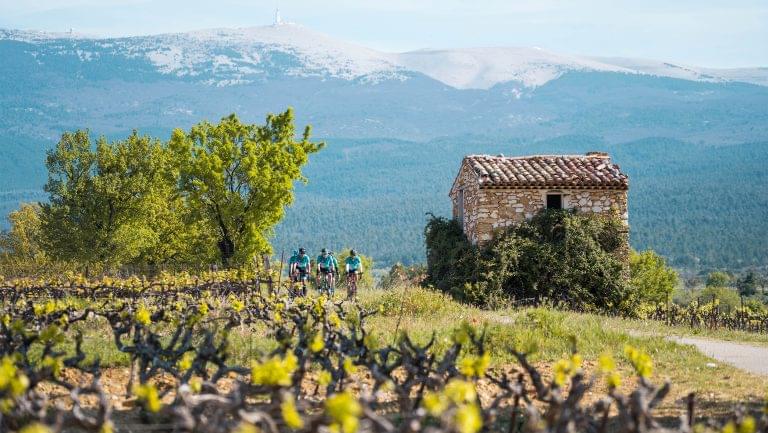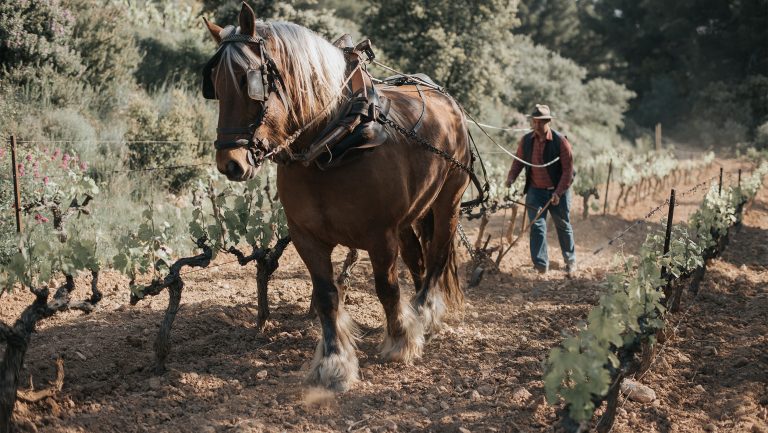It’s possible that more people know the southern Rhône’s Ventoux as the site of an excruciating climb up its namesake mountain in the Tour de France rather than as a wine region.
But this could soon change. Home to some of the coolest vineyard sites in the increasingly-warmer southern Rhône, and land that’s still relatively affordable, more wine producers are looking to Ventoux for its diverse soils and landscapes. As more small vintners reclaim vineyards that have traditionally sent fruit to cooperatives, and with a new AOC president at the helm, the appellation is making moves to address climate change and biodiversity and seeing quality climb higher with every vintage.
Ventoux on a Vision Quest
Originally delineated in 1973, the AOC flew under the name “Côtes du Ventoux” until 2009, when it was switched to Ventoux. Technically, Ventoux is part of the Provence-Alpes-Côtes d’Azur region, but on the wine side of things, it’s somehow clumped in with the Rhône Valley. It borders the Côtes du Rhône AOC, but isn’t a part of it. And making its identity even harder to define, Ventoux is one of the larger AOCs in France, indeterminate and monolithic all at the same time.

Don’t miss the latest drinks industry news and insights. Sign up for our award-winning newsletters and get insider intel, resources, and trends delivered to your inbox every week.
French bureaucracy aside, Ventoux developed a reputation as a region dominated by cooperatives producing very inexpensive wines with an emphasis on quantity. Blending in the southern Rhône is nothing new, as Philippe Gimel of Saint Jean du Barroux says; consider Ventoux’s neighbor, Châteauneuf-du-Pape, which was the first French AOC established in 1936, and growers there planted 13 different varieties, giving more attention to geology and terroir. Ventoux can pull from as many varieties, but with the co-op structure, there’s been little opportunity for the terroir to come through in any discernible way. Rather, the region became a source largely for reds and rosés without much personality.
But there’s a pathway forming for that to change; over the last 20 years, a growing number of small, independent producers have begun to try to carve out a name for Ventoux. In the early 2000s, there were only a couple dozen of such producers. Today there are 130, with growers and winemakers from around the country—and around the globe—finding relatively affordable (around 25,000 euros per hectare, close to prices in Côtes du Rhône and around 20 times less than Châteauneuf-du-Pape) plots to source from.
While the co-ops will always remain an important part of the landscape—they produce about 69 percent of the wine that comes out of Ventoux—smaller producers are becoming a more prominent voice. In a truly landmark change, the region chose Frédéric Chaudière, a third-generation owner and winemaker of Château Pesquié to take on the role of AOC president in 2020, a position forever held by cooperative owners. Chaudière’s family has been a part of Ventoux since 1971, before the AOC even existed; he’s seen the gradual evolution of the region in its entirety.
Chaudière’s first move as AOC president was to poll the region’s growers to get a sense of what their concerns and motivations were. He has initiated a number of research projects in collaboration with geologists to map the soil, altitude, and water resources in the region to help determine the region’s potential.
In October of 2021, under Chaudière’s guidance, Ventoux released a document that outlines its raison d’être, or what Chaudière calls the “purpose” of the AOC, with goals to reach by 2030. This is a wide-angled initiative that looks at everything from increasing (and preserving) biodiversity, to adapting to climate change, to taking a more active role in the culture and tourism of the territory.

Bees, Trees, and Built-In Biodiversity
Perhaps some of the reason that Ventoux has long relied on co-ops for its wine production lies in the fact that the region has never solely been a wine-producing place. “In the Ventoux, when you buy vineyard land,” says Gimel, “it’s usually 50 percent vines and 50 percent fruit trees.” This history of farming diversity—cherry, apricots, prunes, olives, wheat, and lavender—made it so that grapes were just another crop to harvest, hence the rise of co-ops.
While today many wine regions are trying to introduce biodiversity for its widely recognized benefits, in Ventoux it’s always been part of the landscape, and smaller producers are using it to their benefit. Gimel says he has more than 200 different plants in his vineyards, which he likes to call “agroforestry” thanks to the way the vines are nestled amongst the imposing woods. Ventoux has two national parks, two UNESCO reserves, nearly 75,000 acres of forest (to be expanded by 30,000 trees in the next 10 years).
“My husband [Xavier] bought our property, 30 hectares in Ventoux, 28 years ago because he’s a major conservationist,” says Nicole Rolet, co-owner of Chêne Bleu and a vocal ambassador for Ventoux as a region. “At that time, he could have purchased only two hectares in Châteauneuf-du-Pape, [Robert] Parker’s darling.”

The Rolets saw immense opportunity in the cool-climate, biodiverse environment that surrounded the old Grenache and Syrah vines on the property and began looking at the vineyards and terroir in a very focused way. As they dug in, they not only found 1,400 different species of butterflies, but “a Jurassic park of microorganisms in the soils that have been killed off elsewhere,” says Rolet. They’re now in the business of maintaining that, working their vines biodynamically, and collaborating with experts like Claude and Lydia Bourguignon, who are respected throughout France for their soil research. “We’re transmitting a sense of place via microorganisms and minerals,” she explains. The Rolets have also embarked on a project to study the dramatic impact that bees can have on yield size, as well as their ability to propagate natural yeast and spread cover crops.
Today, about 15 percent of the vineyards in Ventoux are farmed organically, but Chaudière expects that number to rise to 25 percent in the next 10 years as small producers get more of a foothold. He says the Mistral, the strong wind that blows from the north through the Rhône Valley on its way to the Mediterranean, tends to keep the sheltered vineyards in Ventoux quite dry (save for some intense late rains in recent vintages), making it an overall hospitable place for organic farming.

Rhône’s Big Air Conditioner
The real draw for Ventoux now is its ability to withstand climate change, thanks in no small part to that attention-seeking 1,912-meter Mont Ventoux at the core of the region and its influence on the wines that are made in its shadows. With temperatures rising in already warm areas throughout the southern Rhône, it has what Chaudière describes as “a kind of air-conditioning effect” on the vineyards. “In the last days of August, a key maturation period for the harvest to come, we have experienced days at 86 to 90 degrees Fahrenheit and nights close to 50 degrees Fahrenheit. These nearly 40 degrees of difference helps give better acidity, freshness, and balance in the wines.”
With so much clamoring over high-altitude vineyards in the wine world these days, there is an important distinction to be made in Ventoux, says James King of Château Unang, who purchased the ancient wine estate in 2003. “Ventoux is more influenced by high altitude rather than being high altitude,” he says. “Our hillside vines are at 350 meters, but they are directly influenced by air coming from the surrounding hills (over 700 meters) and Mont Ventoux.”
It’s this influence of the Mont that Gimel says convinced him that the region is far more Provençal than Rhône-like. The mountain has much more sway over the region than the Rhône River, and the flora that grows in Ventoux is more similar to that surrounding Avignon. The tremendous soil diversity is also a critical point of difference. In Gimel’s vineyards in Le Barroux, which sits along one of the largest geological fault lines on the continent (between Mont Ventoux and the foothills of the Dentelles de Montmirail, a strangely-shaped mountain in the northwest corner of the AOC that forms almost a limestone fence), there are four different geologic periods represented, which means they all have to be planted and treated in different ways.

Experimentation is happening with grape varieties as well. While Ventoux has predominantly been planted with Grenache and Syrah in recent decades, growers like Corinna Faravel of Martinelle and Chaudière at Pesquié are diversifying. Originally from Germany, Faravel bought a 27-acre parcel in Ventoux in 2002 in the Dentelles de Montmirail. While she very much believes in the importance of Grenache in the region, and 60 percent of her vineyards are planted with it, Faravel says she’s planting more Cinsault, Counoise, Tibouren, Picpoul, and Bourboulenc, as a sort of ampelographic study.
“There’s a good initiative in the southern Rhône, reconsidering ancient grape varieties that had been forgotten or officials didn’t want planted because they weren’t consistent,” says Faravel. She’s exploring this—not only to add diversity to the land, but to give more balance to her wine. “Grenache brings a lot of alcohol, so I want to make some different blends, play around with historical varietals to even that out,” she adds.
Chaudière, too, is putting more stock in Carignan, Cinsault, and Counoise: varieties that can be quite vigorous, with big berries, thin skins, light color, and high acidity, which can bring brightness and freshness to his wines. Because of the abundance of limestone soils, ideal for imparting acidity and for cultivating white varieties, “I’m betting on a Clairette revival,” he says. “It has great acid, texture, and structure, and it absorbs the aromas of whatever’s growing around it.”
Perhaps that means we can expect some great whites with scents of forest, almonds, lavender, and honey in the next few years—all a nod to the unique landscape of Ventoux.

Dispatch
Sign up for our award-winning newsletter
Don’t miss the latest drinks industry news and insights—delivered to your inbox every week.
Megan Krigbaum is a wine and drinks writer and a contributor to numerous publications. Before going freelance, she was a wine editor at Food & Wine magazine for ten years.






